Chapelle expiatoire
The Chapelle expiatoire ("Expiatory Chapel")[3] is a chapel located in the 8th arrondissement of Paris, France. The chapel was constructed on the grounds where King Louis XVI and Queen Marie Antoinette had been buried after they had been guillotined, and it is therefore dedicated to them.
| Expiatory Chapel | |
|---|---|
Chapelle expiatoire | |
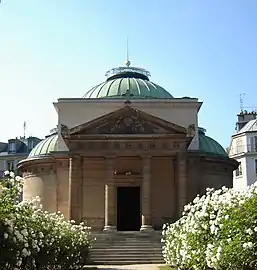 | |
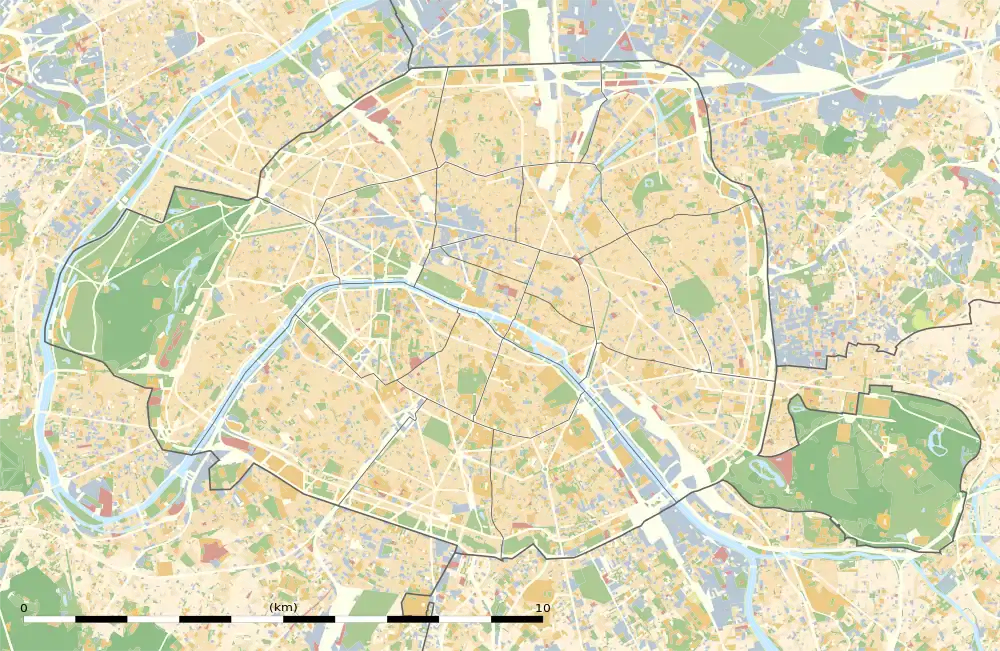 Expiatory Chapel | |
| 48°52′25.5″N 2°19′22.9″E | |
| Location | 29 rue Pasquier, 8th arrondissement of Paris |
| Country | France |
| Denomination | Roman Catholic |
| Website | Official website |
| History | |
| Status | Memorial Chapel |
| Founded | 1816 |
| Founder(s) | Louis XVIII, Duchess of Angoulême |
| Consecrated | January 21, 1824 |
| Architecture | |
| Functional status | Museum |
| Heritage designation | |
| Designated | 1914 |
| Architectural type | church |
| Construction cost | 3,000,000 livres |
| Specifications | |
| Length | 168 feet (51 m) |
| Width | 93.5 feet (28.5 m)[2] |
The closest métro station is Saint-Augustin ![]()
![]() .
.
History and construction
The chapel was designed in 1816 by the French Neo-Classical architect Pierre François Léonard Fontaine, who, with his partner Charles Percier, figured among Napoleon's favourite architects. Fontaine's assistant Louis-Hippolyte Lebas oversaw the construction. The chapel was partly constructed on the grounds of the former Madeleine Cemetery, where King Louis XVI and Queen Marie Antoinette had been buried after they had been guillotined.
King Louis XVIII shared the 3 million livres expense of building the Chapelle expiatoire with the Duchess of Angoulême. Construction took ten years, and the chapel was inaugurated in 1826 in the presence of King Charles X. When he blessed the cornerstone of the Chapelle expiatoire, Hyacinthe-Louis de Quelen, Archbishop of Paris, called in vain for an amnesty of the exiled members of the National Convention.
Building and courtyard

The Chapelle expiatoire stands on a slight rise. There are two buildings separated by a courtyard which is surrounded by an enclosed cloister-like precinct, a peristyle, that isolates the chapel from the outside world. The building on Rue Pasquier is the entrance. There is an inscription above the entrance, which reads (translated):
King Louis XVIII raised this monument to consecrate the place where the mortal remains of King Louis XVI and Queen Marie-Antoinette, transferred on 21 January 1815 to the royal tomb of Saint-Denis, reposed for 21 years. It was finished during the second year of the reign of Charles X, year of grace 1826.[4]
In the courtyard are cenotaphs to those who were known to be buried in this location.
The chapel itself is entered through a pedimented tetrastyle portico, of a sombre Doric order. It contains a domed space at the center of a Greek cross, formed by three coffered half-domed apses with oculi that supplement the subdued natural light entering through the skylight of the main dome. The cubic, semicylindrical and hemispheric volumes recall the central planning of High Renaissance churches as much as they do a Greco-Roman martyrium. White marble sculptures of the king and queen in ecstatic attitudes were made by François Joseph Bosio and Jean-Pierre Cortot. There is also a bas-relief by French sculptor François-Antoine Gérard (who also did some of the other carvings) showing the exhumation and removal of the remains of Louis XVI and Marie Antoinette to the Basilica of St Denis.
The crypt contains a black and white marble altar intended to mark the place where the royal remains were found.
The Chapelle expiatoire is without doubt the most uncompromising late neoclassical religious building of Paris. Chateaubriand found it "the most remarkable edifice in Paris". The chapel's severe geometry is unrelieved by sculpture, as can be seen by the view from rue d'Anjou.
Later history
In 1862, the cypresses which surrounded the chapel were cut down, and a public park (Square Louis XVI) was created around the complex.
In May 1871 the Paris Commune demanded that the Chapel be torn down. This was never put into effect.
Every January 21, a memorial mass is held in the chapel to commemorate the death of Louis XVI.
The Chapel was severely damaged by storm in 2009.
Photographs
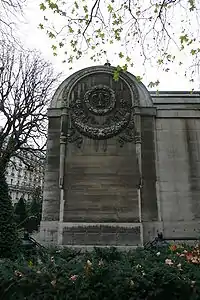 Detail of
Detail of
the left wing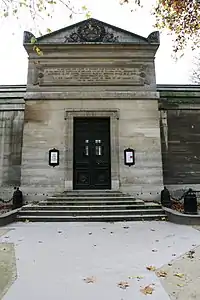 Entrance on
Entrance on
Rue Pasquier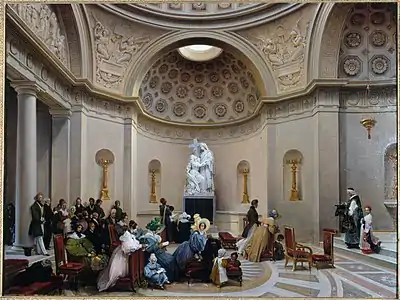 Mass in the chapel (1835)
Mass in the chapel (1835)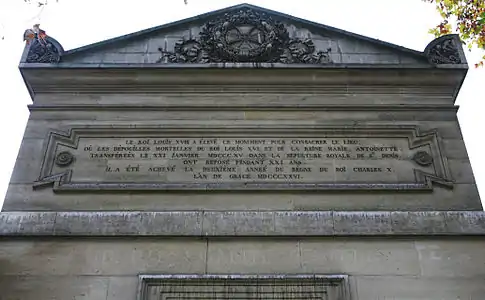 Inscription above
Inscription above
the entrance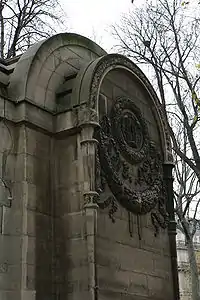 Detail of
Detail of
the right wing Lateral gallery
Lateral gallery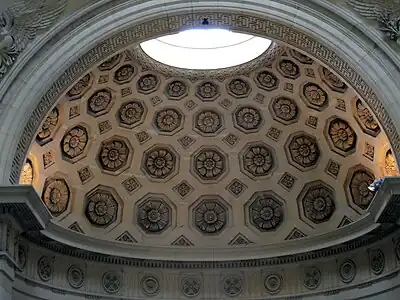 Detail of the apse
Detail of the apse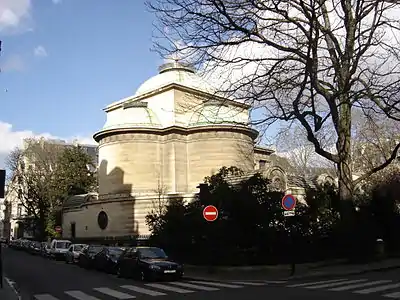 View from
View from
Rue d'Anjou
References
- Base Mérimée: Chapelle expiatoire, Ministère français de la Culture. (in French)
- The History of Paris: From the Earliest Period to the Present Day; Containing a Description of Its Antiquities, Public Buildings, Civil, Religious, Scientific and Commercial Institutions. Paris: A. and W. Galignani. 1825. pp. 119–120.
- expiatoire does not appear in contemporaneous sources; it was added later.
- Le roi Louis XVIII a élevé ce monument pour consacrer le lieu où les dépouilles mortelles du roi Louis XVI et de la reine Marie-Antoinette, transférées le 21 janvier 1815 dans la sépulture royale de Saint-Denis, ont reposé pendant 21 ans. Il a été achevé la deuxième année du règne du roi Charles X, l'an de grâce 1826